Titanium bicycle frames were introduced in the late 1950s and at the time, the exotic material was used by just a few framebuilders. By the late 1960s and early 1970s, titanium was more frequently used for bikes, but not until the 1980s did the metal start to gain appeal among boutique bicycle framebuilders.
While there are a few bike brands producing large production runs of titanium bikes, there are many framebuilders creating functional and fast works of art and speed from titanium. Compared to steel or aluminum, titanium bikes cost more because the raw material is more expensive, is more challenging to weld—requiring the welding area to be bathed in argon gas—and needs different cleaning and finishing processes than steel or aluminum, which requires different machining tools and techniques.
But titanium bikes are no longer unobtainable and can be had without a year’s-long wait list or steep, five-figure price tags. Truckee, California-based Blackheart Bike Co offers nine stock frame sizes, a slew of build options, and takes customization further than most with cerakote color options for some personal flare.
While some high-end custom titanium bike builds can exceed $15,000, Blackheart bikes —manufactured in Taiwan and China and assembled in California— start at $3,149 for a titanium frame and Enve fork. Our 8.11kg test bike as delivered with SRAM Force and Hunt components came in at $7,424—which includes an upgrade to a Red cassette and rainbow-finish chain. While certainly not for those who tend toward budget bikes, the price and weight is comparable to stock carbon bikes by Trek, Specialized and Giant fitted with the same components.
The Blackheart website indicates available stock frames and approximate delivery times without custom finishing, which adds about three weeks for fulfillment. Blackheart indicates a frame and fork can be delivered in as little as a week, while full builds can be shipped in as little as four weeks.
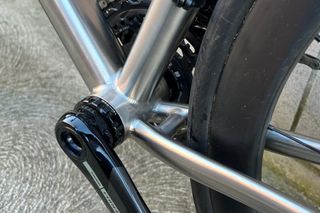
Welds at the bottom bracket look consistent and clean on the Blackheart Road Ti.
(Image credit: Greg Kaplan)
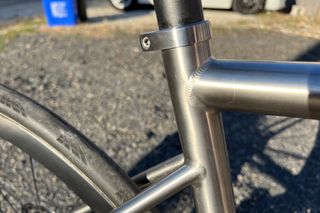
Dropped seatstays on the Blackheart Road Ti? You betcha.
(Image credit: Greg Kaplan)
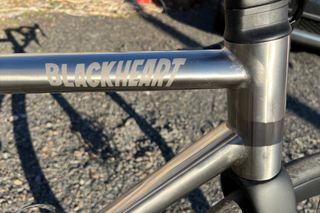
The Blackheart logo, which appears only once on each side of the toptube, is rather subtle.
(Image credit: Greg Kaplan)
With internally routed cables, Kamm-tail aerodynamic tube sections, and integrated cockpit, Blackheart titanium bikes look every bit as aero as a wind-tunnel and CFD- designed carbon bike.
The bike’s spec
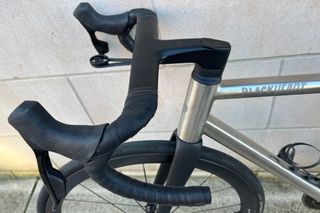
Fully internal routing, Kamm-tail tube shapes, and a minimalist and clean look give the Blackheart Road Ti a contemporary appearance
(Image credit: Greg Kaplan)
Out of the box, the SRAM Force group and Hunt wheels perform flawlessly, as expected. The tubeless wheel and tire setup on this test bike is nearly identical to my own bike: Hunt 44 Aerodynamicist wheels wrapped with 28mm Conti 5000 TR tires, so I was immediately comfortable on this predictable configuration.
I’m confident that this frame could accept 34mm tires, as indicated, with plenty of room to spare. Other available drivetrain options include Shimano 105, Ultegra, and Dura-Ace, SRAM Rival, Force or Red. The SRAM builds are available with the all-road/gravel XPLR option. Two Blackburn carbon cages complete the duotone appearance, and secure bottles well even while ripping atop dirt roads.
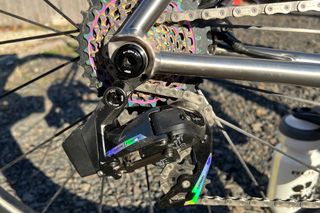
The rainbow finish on the SRAM drivetrain was almost bling enough to distract from the minimal, clean welds at the rear dropouts.
(Image credit: Greg Kaplan)
One minor issue I encountered during assembly were the small cinch bolts in the stem that secure it to the steerer tube pushed through the threads in the stem when tightened with the included 5nm torque key before the clutch in the key engaged. While at first a minor quibble, this frustrated me when the cockpit would not stay aligned with the front wheel. I resorted to using the compression bolt in the stem interface with the fork to help secure the cockpit. Confident that this was not going to be an issue, I put this bike through 90kph descents, and hard cornering.
Founder Zach Lambert says Blackheart spent “years and tens of thousands of dollars of sampling and independent testing” when selecting a carbon supplier. Lambert added this was not previously an issue, and was happy “to dive in further, if needed.”
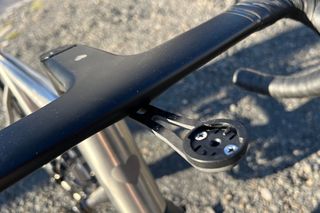
Blackheart integrated cockpits come with a carbon fiber mount that can accommodate a Garmin or Wahoo bike computer.
(Image credit: Greg Kaplan)
Sizing

The Blackheart Road Ti sports a 135mm tall head tube set at 73° with some subtle branding.
(Image credit: Greg Kaplan)
Blackheart does not reinvent the wheel with regards to race bike geometry. While there are slight nuanced differences between the Road Ti and other titanium or carbon racers like Litespeed or Trek, Blackheart is not doing anything unusual.
My own Wisconsin-bred, stock carbon bike has similar length chainstays, 5mm longer wheelbase, 4mm shorter head tube with comparable 73° angle when compared to the Blackheart. But unlike my carbon bike, the Blackheart offers a ride quality that’s slightly more lively and also calming, without noticeable give when asking for accelerations or out-of-the-saddle climbs.
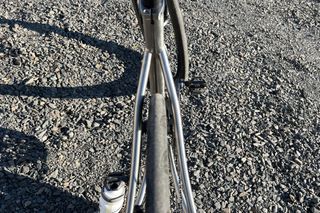
There’s ample clearance for up to 32mm wide tires between slightly swooping seatstays.
(Image credit: Greg Kaplan)
The Enve fork on the Blackheart has a 43mm offset with 57mm trail compared to the 45mm offset and 56mm trail on my regular ride.
Looking at the titanium offering from a premium Colorado-based titanium bike manufacturer, a similarly sized 54cm frame also has 410mm chainstays, 130mm length headtube at a 72.5° angle, and an identical Enve fork. Both ti bikes have 74° seat tube angles.
Ride feel
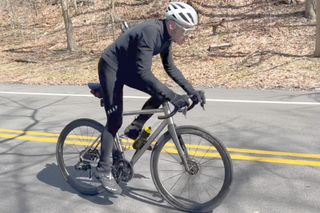
The Blackheard Road Ti responds quickly and offers a firm, stable, and supportive feel when climbing out-of-the-saddle.
(Image credit: Greg Kaplan)
I liken the feeling of riding a titanium to the difference when listening to headphones with noise-canceling disabled—you hear your tunes, as well as a bit of your surroundings—instead of muting background noise and getting only what you pay for coming through a headset. Immediately noticeable when riding the Blackheart is how it ever-so-slightly calms the ride compared to my carbon racer, and is more lively than other titanium bikes I’ve ridden. The Blackheart allows some feel to creep in for a feeling of connection to the road, which is more refined than the harsh feel of aluminum, or overly compliant feel of steel. One of the fun parts about riding a titanium bike is the firm resiliency of the frame, and Blackheart tunes the ride feel to let this come through.
Even when I dive the bike into a corner, or jump out of the saddle for a punchy climb, the Blackheart smooths the transition from punchy riding to smooth and steady. In the past, this quality of titanium bikes might have been described as laggy or springy, but not so with the Blackheart. Can this bike be used as a crit racer? Sure, but the feeling this bike imparts is closer to a classics racer than a thrash-about cornering king. But to be sure, there is no indication of any forgiving spring-back feel that I expected before my first few rides
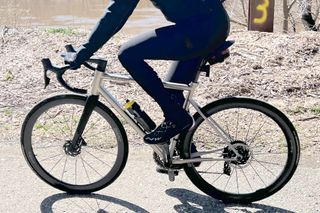
Riding on smooth roads and multi-use paths, the Blackheart feels so smooth, while not isolating the rider or muting the ride.
(Image credit: Greg Kaplan)
Although Blackheart also offers the All Road titanium bike, which can accommodate wider (32mm and greater) tires, the Road Ti rides light gravel and hardpack dirt roads so well with 28mm tires. Of course 30mm or 32mm would be even more plush. Unlike riding a carbon bike on unpaved roads when flying bits of stones that could ding or crack the frame, there’s never any worry about this when riding a titanium bike. The Road Ti is just as fun and offers the same confidence and control off-road as on asphalt, with less concern about chipped carbon.
Value & Verdict
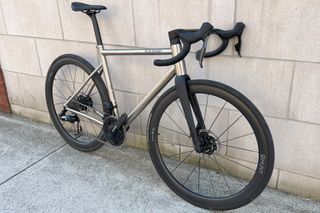
Aero is still everything and the Blackheart Road Ti has all the low-drag shapes, hidden hoses, and an integrated front end for a clean look that looks every bit as fast as you’d expect from a race bike.
(Image credit: Greg Kaplan)
The Blackheart Road Ti is a firm, responsive and lively ride, offering a calm and refined feel for a fraction of the cost of other titanium racing bikes. For those looking for the last bike they might buy, or one bike to do it all, or simply to add one more bike to their scuderia, the Blackheart Road Ti gets our approval.
The Road Ti is price-competitive with many stock carbon racers, and just a few other titanium bikes, with a lower price tag. For those who want a bike that stands out in a group ride, the understated styling of the Blackheart certainly gets noticed.

